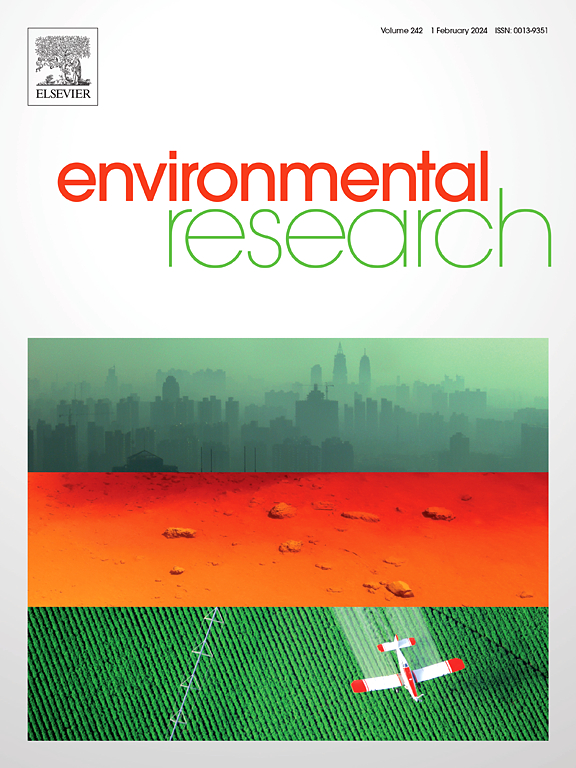Ecological impacts of treated effluent on multitrophic biodiversity and their interactions
IF 7.7
2区 环境科学与生态学
Q1 ENVIRONMENTAL SCIENCES
引用次数: 0
Abstract
The reuse of water, particularly treated effluent from wastewater treatment plants (WWTPs), is a crucial and sustainable strategy for mitigating water scarcity, especially in megacities with high water demand and limited resources. However, the ecological risks associated with effluent discharge into receiving waterbodies have gained significant global attention. Understanding the dynamic effects of WWTP effluent on multi-trophic groups and their interactions is essential for assessing ecological impacts in aquatic ecosystems and informing management strategies. In this study, we examined five taxonomic groups representing different trophic levels of the freshwater food web - bacteria (decomposers), algae (primary producers), zooplankton (primary consumers), and benthic macroinvertebrates and fish (predators) - across two rivers to elucidate ecological responses to WWTP effluent from a multi-trophic perspective. Our results revealed significant but variable biological responses among these groups, depending on river conditions and trophic level. In the nutrient-rich river, primary consumers (zooplankton) were most affected, whereas in the nutrient-poor river, primary producers (algae) exhibited the strongest responses primarily derived from environmental disturbances. Notably, interactions between environmental variables and taxa were highly diverse, with trophic dynamics influenced by both bottom-up and top-down processes in the nutrient-rich river, whereas bottom-up effects dominated in the nutrient-poor river. Furthermore, niche overlap in algae-zooplankton networks was higher in the nutrient-rich river than in the nutrient-poor river. This study underscores the importance of integrating multi-trophic biodiversity profiling and trophic interaction analyses to comprehensively assess the ecological effects of WWTP effluent in receiving aquatic ecosystems with contrasting environmental contexts. Our findings highlight the importance of conservation and sustainable management practices, especially in urban aquatic ecosystems located in (semi-)arid regions that experience prolonged periods of low precipitation.

污水处理对多营养生物多样性的生态影响及其相互作用
水的回用,特别是污水处理厂(WWTPs)处理后的污水,是缓解水资源短缺的一项重要的可持续战略,尤其是在水资源需求量大而资源有限的特大城市。然而,污水排放到受纳水体所带来的生态风险已引起全球的高度关注。了解污水处理厂污水对多营养群的动态影响及其相互作用,对于评估水生生态系统的生态影响和制定管理策略至关重要。在本研究中,我们考察了两条河流中代表淡水食物网不同营养级的五个分类群--细菌(分解者)、藻类(初级生产者)、浮游动物(初级消费者)以及底栖大型无脊椎动物和鱼类(捕食者),从多营养级的角度来阐明污水处理厂污水的生态响应。我们的研究结果表明,根据河流条件和营养级的不同,这些群体之间的生物反应显著但各不相同。在营养物质丰富的河流中,初级消费者(浮游动物)受到的影响最大,而在营养物质贫乏的河流中,初级生产者(藻类)的反应最强烈,主要是由于环境干扰。值得注意的是,环境变量与分类群之间的相互作用是高度多样化的,在营养丰富的河流中,营养动态受到自下而上和自上而下过程的影响,而在营养贫乏的河流中,自下而上的影响占主导地位。此外,营养丰富的河流中藻类-浮游动物网络的生态位重叠程度高于营养贫乏的河流。本研究强调了综合多营养生物多样性剖析和营养相互作用分析的重要性,以全面评估污水处理厂污水在环境背景截然不同的受纳水生生态系统中的生态效应。我们的研究结果强调了保护和可持续管理实践的重要性,尤其是在位于(半)干旱地区、降水量长期偏低的城市水生生态系统中。
本文章由计算机程序翻译,如有差异,请以英文原文为准。
求助全文
约1分钟内获得全文
求助全文
来源期刊

Environmental Research
环境科学-公共卫生、环境卫生与职业卫生
CiteScore
12.60
自引率
8.40%
发文量
2480
审稿时长
4.7 months
期刊介绍:
The Environmental Research journal presents a broad range of interdisciplinary research, focused on addressing worldwide environmental concerns and featuring innovative findings. Our publication strives to explore relevant anthropogenic issues across various environmental sectors, showcasing practical applications in real-life settings.
 求助内容:
求助内容: 应助结果提醒方式:
应助结果提醒方式:


